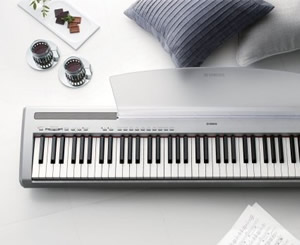
Introduction
Yamaha's new P85 digital piano is the next chapter after the P70. With its beautiful grand piano sounds, 64 notes of polyphony, new recording capabilities, and new front panel, the P85 is one very capable and portable digital piano.
Overview
One of the first things we noticed about the P85 is its new front panel. No longer do you have to strike a key to select a voice. The P85's panel has a button for every voice. Another long awaited new feature is the 64 notes of polyphony—twice as much as the P70, so, no more worries of voices getting stolen while playing anymore. Also, like the P70, the P85's keyboard is graded heavier toward the bass region and becomes lighter up the keyboard for a very authentic grand piano touch.
Sounds
The Yamaha P85's voices are very much the same as the P70's. However, all the voices are of decent quality—the grand piano voices are good so are the organs, strings, harpsichord, and vibraphone. In particular, we really liked the electric pianos. They were programmed with dynamic samples so the harder the piano is played the more the tone changes, thus, allowing more expression.
Recording
The P85 has the capability to record your compositions. This is a nice feature especially for jotting down song ideas quickly and conveniently. Recording is very straightforward; choose your instrument, press REC, and play. The onboard recorder will record up to 65KB of data (about 11,000 notes) and will save one song at a time. However, you can transfer your compositions between the keyboard and your computer via MIDI with a USB-MIDI interface (i.e. Yamaha’s UX16 USB-MIDI interface). Overall, we applaud Yamaha for adding this feature to the P85 without raising the price tag.
Other Features
The Yamaha P85 comes with a reverb effects processor where you can choose from several different reverbs and adjust your wet/dry mix, dual mode where you can select any two voices and adjust their volumes and octaves to each other, touch sensitivity, transpose, and fine tuning settings to precisely tune the P85 to any instrument.
The P85 can also be expanded with optional features such as a 3-pedal unit with half damper capabilities (LP-5, $69.99), keyboard stand (L-85/L-85S, $99.99), single foot pedals (FC3, $39.99, FC4, $24.99) and USB-MIDI interface cable (UX16, $39.95). Finally, the P85 comes with the FC5 foot pedal, power adapter, Owner's Manual and comes in a choice of either a black or silver finish.
Conclusion
The Yamaha P85 is a decent jump up from the P70. We were pleased by its new recording feature, 64 notes of polyphony, easier front panel voice access and 3-pedal unit that's half damper capable (optional item). For all the improvements and new features in the P85, we were impressed that Yamaha kept its price to that of the P70.
The P85 would be a great digital piano for music students and children to learn on and we highly recommend it at YamahaMusician.com.


